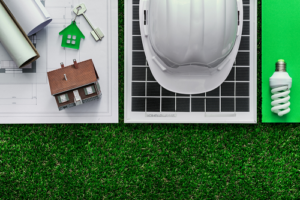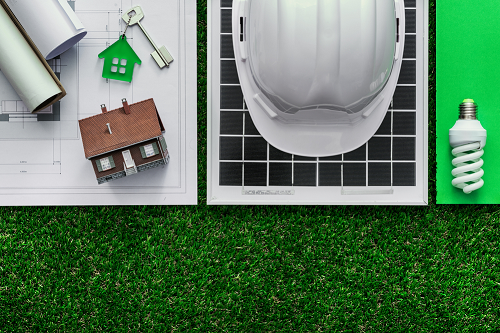Between concerns over climate change, diminishing resources, economic and social unrest, and a growing awareness of our corporate environmental accountability, green building is a pressing issue.
But this wasn’t always the case.
It wasn’t until the last few decades that the concept of green building and sustainability really took hold in the collective consciousness of the developed and developing nations of the world. However, the concepts underpinning them have a much older history.
One source dates the origin of the term “sustainability” back to the early 18th century,
“Coined in German, the original term was Nachhaltigkeit, meaning “sustained yield.” It first appeared in a handbook of forestry published in 1713, and was used to mean never harvesting more than the forest can regenerate. The translated term appeared in English beginning in the mid-19th century.”
And another source contends that,
“At the start of the 1970s the term ‘sustainable development’ was coined, probably by Barbara Ward (Lady Jackson), founder of the International Institute for Environment and Development.”
Fast forward a decade or so and the concept appears to have been “developed,” so to speak, into the current construct, according to the Sustainability for All website,
“It seems incredible but the ‘sustainability’ concept as we know it today dates back to under 30 years ago: it appeared for the first time in 1987 in the famous Brundtland Report (also entitled ‘Our Common Future’) produced by several countries for the UN.”
Simply put, green building and sustainability development that meets the present needs without compromising the capacities of future generations, and ensures the balance between economic growth, environmental care, and social welfare.

Pursuing sustainability is to promote the awareness and diffusion of green practices that combine economic and social development with the preservation of natural resources.
Green Building and Sustainability – Looking Ahead
According to recent research from JP Morgan, buildings represent around 40 percent of both global energy use and the emission of greenhouse gas, or GHG. The solution to this problem is in pursuing green building with sustainable practices.
But the building sector has been slow to make the transition, although this is now changing.
Green building is defined by the US Environmental Protection Agency (EPA) as using more environmentally friendly and resource-efficient processes throughout a building’s life-cycle in areas such as construction, renovation, operation, maintenance, and demolition.
According to Daniel Rozier, CFA, Senior Vice President and Research Analyst at Lazard Asset Management in the UK,
“Building energy efficiency is gaining traction, largely because of buildings’ significant 40% share of global energy consumption. Falling costs, combined with government support and more sustainably conscious building owners and users, is helping drive green building through the adoption of more efficient technologies such as heat pumps, advanced ventilation systems, and smart building applications.”
More recent disruptions in construction costs, shipping issues with China, and other problems, may prove to sideline some projects and initiatives for the immediate future. But the growing trend of sustainability seems to have a substantial momentum.
In fact, according a recent article from Environmental Leader,
“The Biden administration is focusing on building decarbonization with the goal of tripling efficiency and seeing up to US $200 billion in savings. This includes investing in worker training, a grid-interactive efficient buildings (GEB) ‘roadmap,’ and new building performance standards for the federal government, spearheaded by the Council on Environmental Quality.”
Whether these prove to be mere political gestures or actionable policies, they serve to underscore the widespread awareness of and growing commitment to sustainable and green construction and building maintenance.
Considering Green Building and Sustainability at Home
Commercial structures only make up a portion of the buildings existent in the world. Single-family homes and multi-family units such as apartments and condominiums make up a significant number of building structures.
And, when it comes to homes, the trend towards green and sustainable construction and living is widespread.
As one article noted,
“New homeowners don’t want old houses, as they want to stay away from asbestos-filled insulation, galvanized piping, expensive maintenance cost, and outdated and inefficient energy systems. Rather, they seek sustainable solutions that don’t just provide modern comfortable living but also give back and help the environment.
It’s no secret that buildings contribute to climate change through greenhouse gas emissions. But with 1.4 million homes built each year, construction firms have all the opportunities to play their part in saving the planet by embracing greener practices.”
While California leads the nation here in the U.S. in terms of energy codes, other states are rapidly following suit. In California, for example, it used to be that only state-owned buildings were expected to comply with the state’s Title 24 regulations. Today, however, this has been expanded to cover all buildings in the state and now includes new home construction and remodeling projects.
Which is where the knowledge and assistance of a reliable construction consultant comes in.
Your Resource for Knowledgeable Green Building Consulting
Green building and sustainable living are the future, both for businesses and residential structures.
Green living is attainable but having an experienced and knowledgeable professional can make the process much easier for homeowners, contractors, and business owners who want to benefit by implementing green and sustainable building practices.
Whether you’re a contractor about to build a home, a homeowner planning to build your own home or an addition, or a business owner who wants to create a more sustainable facility, sustainability consulting can benefit you.
A sustainable construction consultant can provide guidance and direction for any aspect of a project, whether it involves new construction, retrofitting for energy efficiency, or simply adding or upgrading energy saving components.
As an experienced construction consultant, I can guide you in all the phases of your project and answer your questions. To learn more, email me at crystalconstructionconsulting@gmail.com or give me a call at (707) 865-5157.

